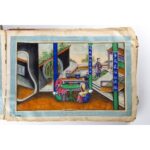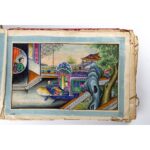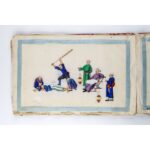Album of Chinese paintings with scenes of women and children
A Qing Dynasty album consisting of twelve paintings of the everyday lives of court ladies, showing them playing instruments, observing their surroundings, chatting, babysitting, and playing board games. The ladies are wearing traditional clothes, and they are surrounded by peonies, willows, plum trees, and many other flowers and trees. Chinese characters can be seen on the pictures, describing a pleasant and relaxed atmosphere. The cover of the album is covered with red silk and features symbols of longevity, luck, strength, and wealth.
The paper on which the murals are painted is made from the wood of the small evergreen tree tongcao 通草 (Tetrapanax papyrifer). Branches or trunks of the tree were cut into short pieces and soaked, the pulp was extracted, and they were then skilfully cut into thin leaves. The resulting paper had a soft and velvety texture, which is why it was compared to cloth. It was also very fragile, and the paintings could be easily damaged, ... more
A Qing Dynasty album consisting of twelve paintings of the everyday lives of court ladies, showing them playing instruments, observing their surroundings, chatting, babysitting, and playing board games. The ladies are wearing traditional clothes, and they are surrounded by peonies, willows, plum trees, and many other flowers and trees. Chinese characters can be seen on the pictures, describing a pleasant and relaxed atmosphere. The cover of the album is covered with red silk and features symbols of longevity, luck, strength, and wealth.
The paper on which the murals are painted is made from the wood of the small evergreen tree tongcao 通草 (Tetrapanax papyrifer). Branches or trunks of the tree were cut into short pieces and soaked, the pulp was extracted, and they were then skilfully cut into thin leaves. The resulting paper had a soft and velvety texture, which is why it was compared to cloth. It was also very fragile, and the paintings could be easily damaged, so they were laminated with stiffer paper. The edges of the paintings were bordered with Chinese silk ribbon or coloured paper. Artists made the albums in their studios and workshops in Canton. Such paintings were very popular, being small, portable and cheap souvenirs that travellers, sailors and other foreigners could take home. (TV)





























































Do you have a comment or additional information about the subject?